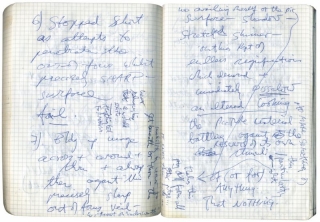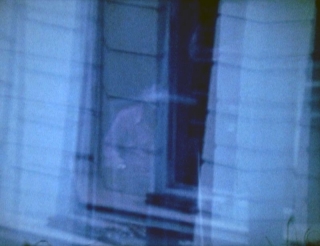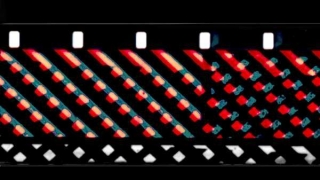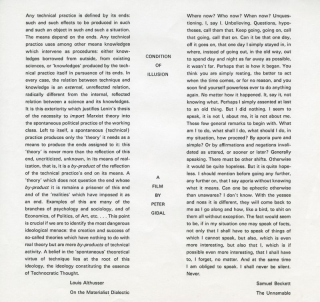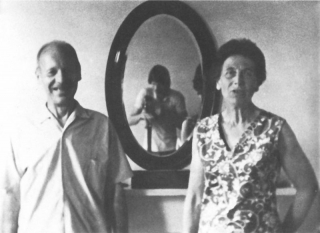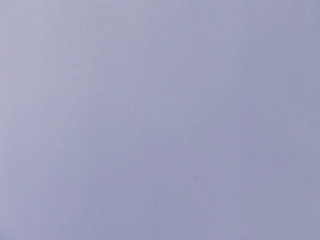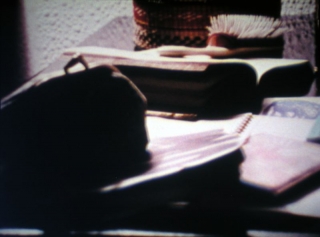Date: 7 October 2016 | Season: Peter Gidal: Flare Out
INTRODUCTION TO PETER GIDAL 1
Friday 7 October 2016, at 9pm
Brussels Cinematek
Introduced by Peter Gidal and Mark Webber
From his first period (Clouds, 1969) to his latest film (not far at all), through Flare Out, the 1992 film that gives the recent book from The Visible Press its title, Gidal frames empty skies and a volcano to question, by the means of film, what the viewer believes he sees and “[to pose] the basic questions of aesthetics, what it is to view, how to view the unknown as to view the known is not possibly a viewing.” —Olivier Dekegel
Peter Gidal, Clouds, 1969, 10 min
Peter Gidal, Flare Out, 1992, 20 min
Peter Gidal, Volcano, 2002, 30 min
Peter Gidal, not far at all, 2013, 15 min
Date: 8 October 2016 | Season: Peter Gidal: Flare Out
INTRODUCTION TO PETER GIDAL 2
Saturday 8 October 2016, at 3pm
Brussels Cinematek
Introduced by Peter Gidal and Mark Webber
Two short and one medium length film from Peter Gidal’s first period. A very famous folk singer of the time is invoked, incognito (Key) but – above all – many elements of the film language (editing and jump-cut, repetition, duration, zoom, focus, blur, etc.) are used to question film, and our gaze. Jonas Mekas was an admirer of Room Film 1973: “I was particularly impressed with Gidal’s film, which from what I’ve seen may be his best to date. Very subtly and very plastically it deals with light. The film is uncompromisingly rigid in its minimality of action. A very beautifully realised piece of work […] It is denitely contemporary in feeling and substance. It is one of the best lms to come out of the London School.” —Olivier Dekegel
Peter Gidal, Hall, 1968-69, 10 min
Peter Gidal, Key, 1968-69, 10 min
Peter Gidal, Room Film 1973, 1973, 46 min (at 18fps)
Date: 9 October 2016 | Season: Peter Gidal: Flare Out
INTRODUCTION TO PETER GIDAL 3
Sunday 9 October 2016, at 4pm
Brussels Cinematek
Introduced by Mark Webber
From C/O/N/S/T/R/U/C/T, shown in Knokke, to the diptych Coda I + Coda II in 2013, in which the filmmaker uses a recording of the voice of William Burroughs, we get an overview of Gidals structural/materialist cinema, that refuses a ‘subject-centred image’ and is resolutely ‘anti-voyeuristic’. As for Assumption, it offers an approach to life at the London Film-Makers’ Co-op which goes beyond the history of an organisation and includes a tribute to Mary P. Leece, founder of the Four Corners film workshop. —Olivier Dekegel
Peter Gidal, Assumption, 1997, 1 min
Peter Gidal, Epilogue, 1978, 9 min
Peter Gidal, C/O/N/S/T/R/U/C/T, 1974/2016, 13 min
Peter Gidal, Condition of Illusion, 1975, 30 min
Peter Gidal, Coda I, 2013, 2 min
Peter Gidal, Coda II, 2013, 2 min
Screening repeats Monday 10 October, at 6pm
Date: 13 October 2016 | Season: Shoot Shoot Shoot 2016 | Tags: Shoot Shoot Shoot
SOFT FLOOR, HARD FILM: CELEBRATING 50 YEARS OF THE LONDON FILM-MAKERS’ CO-OP
Thursday October 13 2016, at 7pm
London ICA Theatre
To mark the 50th anniversary, to the day, since the founding of the London Film-makers’ Co-operative (LFMC), LUX launches the new publication Shoot Shoot Shoot: The First Decade of the London Film-Makers’ Co-operative 1966-76, edited by Mark Webber.
Organised in conjunction with Frieze Video and the ICA’s Artists’ Film Club, the evening will feature a newly commissioned short film about the LFMC, produced by Frieze in collaboration with artist and writer Matthew Noel-Todd, who will also chair a discussion with Mark Webber, Malcolm Le Grice and Lis Rhodes on the organisation’s early ideals and ongoing legacy. The panel will be followed by a special presentation of Lis Rhodes’ seminal expanded cinema piece Light Music (1975-77).
The LFMC was established on 13 October 1966. A telegram published in the first issue of the Co-op’s magazine Cinim declared:
“LONDON FILM-MAKERS COOP ABOUT TO BE LEGALLY ESTABLISHED STOP PURPOSE TO SHOOT SHOOT SHOOT SHOOT SHOOT STOP NEVER STOP NO BREAD NO PLACE TO LAY OUR HEADS NO MATTER JUST MIND IF YOU WANT TO MAKE MONEY STOP IF YOU LIKE BRYAN FORBES STOP IF YOU READ SIGHT AND SOUND STOP IF YOU WANT TO MAKE FILMS I MEAN FILMS COME ALL YOU NEEDS IS EYES IN THE BEGINNING STOP GEN FROM 94 CHARING CROSS ROAD W.C.2 PARTURITION FINISHED SCREAMS BEGIN STOP”
The 1960s and 1970s were a defining period for artists’ film and video, and the LFMC was one of its major international centres as an artist-led organisation that pioneered the moving image as an art-form across the UK. Shoot Shoot Shoot: The First Decade of the London Film-Makers’ Co-operative 1966-76 documents its beginnings, tracing its development from within London’s counterculture towards establishing its own identity within premises that uniquely incorporated a distribution office, cinema space and film workshop.
Date: 20 October 2016 | Season: Shoot Shoot Shoot 2016 | Tags: Shoot Shoot Shoot
SHOOT SHOOT SHOOT: THE LONDON FILM-MAKERS’ CO-OP
20 October—1 November 2016
New York Anthology Film Archives
The London Film-Makers’ Co-operative was founded 50 years ago in October 1966. Inspired by the example set by Jonas Mekas and his colleagues in New York, the LFMC grew from its beginnings as a film-viewing group for London’s intellectual counterculture to become of the major centers of a worldwide network of avant-garde film culture. In contrast to similar organizations, the LFMC’s activity was not limited to distribution – within a few years it was also running a regular program in its own cinema and, most notably, democratized the means of production by establishing a film workshop in which filmmakers could control every stage of the creative process.
The work made in this supportive environment was diverse, though two tendencies came to dominate the discourse: structural/materialism and expanded cinema. The materialist qualifier that distinguished British work from the American structural film refers both to Marxist philosophy and the physical presence of the medium that was foregrounded in films produced in the LFMC workshop. European expanded cinema largely eschewed the associations of psychedelia and expanded consciousness as formulated in Gene Youngblood’s book and instead extended the formal exploration of film to the moment of its presentation. The term was used to describe a range of work including multi-screen films, live performances and continuous installations that made innovative use of the mechanics of projection.
Filmmakers associated with the LFMC during its early years include Stephen Dwoskin, Malcolm Le Grice, Peter Gidal, Annabel Nicolson, Sally Potter, Anthony McCall, Lis Rhodes, Guy Sherwin and John Smith. The organization survived in run-down premises, with little or no public funding, for more than thirty years until its enforced dissolution and merger with London Electronic Arts. Since 2002, LUX has distributed the former LFMC collection and promoted its legacy alongside the work of contemporary film and video artists.
Shoot Shoot Shoot: The First Decade of the London Film-Makers’ Co-operative 1966–76, edited by Mark Webber, will be published by LUX in October 2016. The book gathers together texts, images and archival documents and is illustrated throughout in full color.
“Shoot Shoot Shoot: The London Film-Makers’ Co-op”, and the related series “Peter Gidal: Flare Out” and “From Reel to Real”, are presented by Anthology Film Archives in association with LUX, London.
Date: 20 October 2016 | Season: Shoot Shoot Shoot 2016 | Tags: Shoot Shoot Shoot
SHOOT SHOOT SHOOT PROGRAM 1
Thursday 20 October 2016, at 7:30pm
New York Anthology Film Archives
It was the film workshop that set the structure of the LFMC apart from other film co-ops. The facility housed a continuous processor and step printer that enabled filmmakers to work directly with the medium, without the need or expense of commercial laboratories, and provided a set of technical parameters that enabled a school of filmmaking to develop. This program spotlights works that were, more or less, produced within that environment, from the more playful films of Annabel Nicolson and Marilyn Halford, to one of Malcolm Le Grice’s early loop-based found footage meditations on the military/industrial complex. Mike Leggett’s seminal process-piece Shepherd’s Bush, a measured passage from darkness to light, was conceived as a test for the Co-op’s step printer but is nonetheless a cathartic experience for the viewer. Chris Garratt’s Versailles I & II and Lis Rhodes’ dynamic Dresden Dynamo explore the possibilities of using visual imagery to create optical sound on 16mm film.
Annabel Nicolson, Frames, 1973, 16mm, 18fps, color, silent, 8 min
Marilyn Halford, Footsteps, 1975, 16mm, b/w, sound, 7 min
Mike Leggett, Shepherd’s Bush, 1971, 16mm, b/w, sound, 15 min
David Crosswaite, Film No. 1, 1971, 16mm, color, sound, 10 min
Lis Rhodes, Dresden Dynamo, 1971-72, 16mm, color, sound, 4 min
Chris Garratt, Versailles I & II, 1976, 16mm, b/w, sound, 11m
Malcolm Le Grice, Reign of the Vampire, 1970, 16mm, b/w, sound, 16 min
Date: 23 October 2016 | Season: Peter Gidal: Flare Out
PETER GIDAL: FLARE OUT
23—24 October 2016
New York Anthology Film Archives
“He draws out singularities. He allows the camera only a fenced in area, piecemeal. He lets the gaze hold on objects and constantly repeats … this permits the possibilities of the discrepancies between one’s own seeing and seeing with the camera to become distinct, and this in turn allows for a completely different experience of the surroundings.” (Birgit Hein)
For five decades, Peter Gidal has sought to problematize the film-viewing process by creating works that resist recognition and identification. His practice posits film as a durational experience and negates analysis on psychological grounds. These two programs survey his radical approach, ranging from the seminal early works Hall and Clouds (1969) to the recent Coda I, Coda II and not far at all (2013).
Gidal has lived in the UK since the late 1960s and was a central figure during the formative years of the London Film-Makers’ Co-operative. He is a noted writer and polemicist, whose “Theory and Definition of Structural/Materialist Film” is a key text of avant-garde cinema.
Following the recent publication of a collection of Gidal’s essays, Jonathan Rosenbaum commented: “The singular way that Peter Gidal wrestles with language is a continual lesson in philosophy, aesthetics, ideology, and politics. Flare Out: Aesthetics 1966–2016 charts his ongoing struggles with wit, lucidity, and genuine brio.”
Flare Out: Aesthetics 1966–2016, edited by Mark Webber and Peter Gidal, is published by The Visible Press. In addition to many texts relating to film, it also includes essays on the work of Samuel Beckett, Thérèse Oulton, Gerhard Richter and Andy Warhol.
Date: 23 October 2016 | Season: Shoot Shoot Shoot 2016 | Tags: Shoot Shoot Shoot
SHOOT SHOOT SHOOT PROGRAM 2
Sunday 23 October 2016, at 6pm
New York Anthology Film Archives
This second glimpse at the first decade of the London Film-Makers’ Co-op anticipates some of the new directions that followed in later years. Short Film Series is an open-ended set of observational pieces by Guy Sherwin, each the length of a 16mm film roll. Mike Dunford’s Still Life with Pear wittily deconstructs the act of filming, and John Smith constructs a word game of visual puns in Associations. Finally, two double 16mm projection serve as examples of British expanded cinema: Gill Eatherley’s understated feminist ‘room film’, and River Yar, Raban & Welsby’s majestic time-lapse study of a tidal river estuary.
Guy Sherwin, Short Film Series: Vermeer Frames/Chimney/Portrait with Parents/Metronome, 1974-78, 16mm, b/w, silent, 14 min
Mike Dunford, Still Life with Pear, 1973, digital, b/w, sound, 14 min
John Smith, Associations, 1975, 16mm, color, sound, 7 min
Gill Eatherley, Pan Film, 1972, 2 x 16mm, b/w, silent, 8 min
Chris Welsby & William Raban, River Yar, 1972, 2 x 16mm, color, sound, 35 min
Date: 23 October 2016 | Season: Peter Gidal: Flare Out
PETER GIDAL: FLARE OUT PROGRAM 1
Sunday 23 October 2016, at 8:15pm
New York Anthology Film Archives
“Manipulation of response and awareness thereof: through repetition and duration of image. Film situation as structured, as recorrective mechanism.” (Peter Gidal, 1969)
The early film Hall presents a fixed view across a space of indeterminate depth that is continually disrupted by jump cuts and repeats. Despite the incessant ringing of (what may be) a doorbell, it is one of Gidal’s more accessible works. By the mid-1970s, the profilmic event had been entirely thrown into question. Variations in camera movement, lighting, exposure, focus, zooms, shot duration, repetition, and filming from photographs (rather than ‘reality’) were established as methods through which identification of/with an image could be negated. In Condition of Illusion the image remains unstable until the final section, a scrolling text with extended quotes from Althusser and Beckett. Other works do not contain similarly readable content: Flare Out is “out of time in time; not not knowing the unknown but not knowing the known, no trace of ‘no trace of any thing’,” the Codas (commissioned by Frieze, snatches of Burroughs on the soundtrack), “a complex of barely visible cuts in space and time, the opposite of erasure, but nothing so much as visible.”
Peter Gidal, Hall, 1969, 16mm, color, sound, 10 min
Peter Gidal, Condition of Illusion, 16mm, color, silent, 1975, 30 min
Peter Gidal, Flare Out, 1992, 16mm, color, sound, 20 min
Peter Gidal, Coda I, 2013, 16mm, color, sound, 2 min
Peter Gidal, Coda II, 2013, 16mm, color, sound, 2 min
Date: 24 October 2016 | Season: Peter Gidal: Flare Out
PETER GIDAL: FLARE OUT PROGRAM 2
Monday 24 October 2016, at 7pm
New York Anthology Film Archives
“Mental activation toward material analysis is the process that is relevant, whether or not actual structure is ‘revealed’.” (Peter Gidal, 1969)
Clouds was the first real manifestation of Gidal’s anti-illusionist project, a film in which “There is virtually nothing on screen, in the sense of in screen. Obsessive repetition as materialist practice not psychoanalytical indulgence.” Assumption is, by stark contrast, exhilarating viewing. One of the densest minutes of all cinema, the screen bristles with recognizable images, fleeting texts and snatches of dialogue in tribute to filmmaker/activist Mary Pat Leece. Silent Partner and Epilogue return to the more familiar territory of domestic interiors, inhabited spaces interrogated by a restless camera. Anti-narrative, against representation, militant and uncompromising, yet despite themselves, strangely compelling. After a hiatus from filmmaking, Gidal returned in 2013 with not far at all: “tempted to say different yet the same, but not.” The film was awarded the L’age d’or Prize at the Brussels Cinematek in 2015.
Peter Gidal, Assumption, 1997, 16mm, color, sound, 1 min
Peter Gidal, Clouds, 1969, 16mm, color, sound, 10 min
Peter Gidal, Silent Partner, 1977, 16mm, color, sound, 35 min
Peter Gidal, Epilogue, 1978, 16mm, color, silent, 7 min
Peter Gidal, not far at all, 2013, 16mm, color, sound, 15 min
